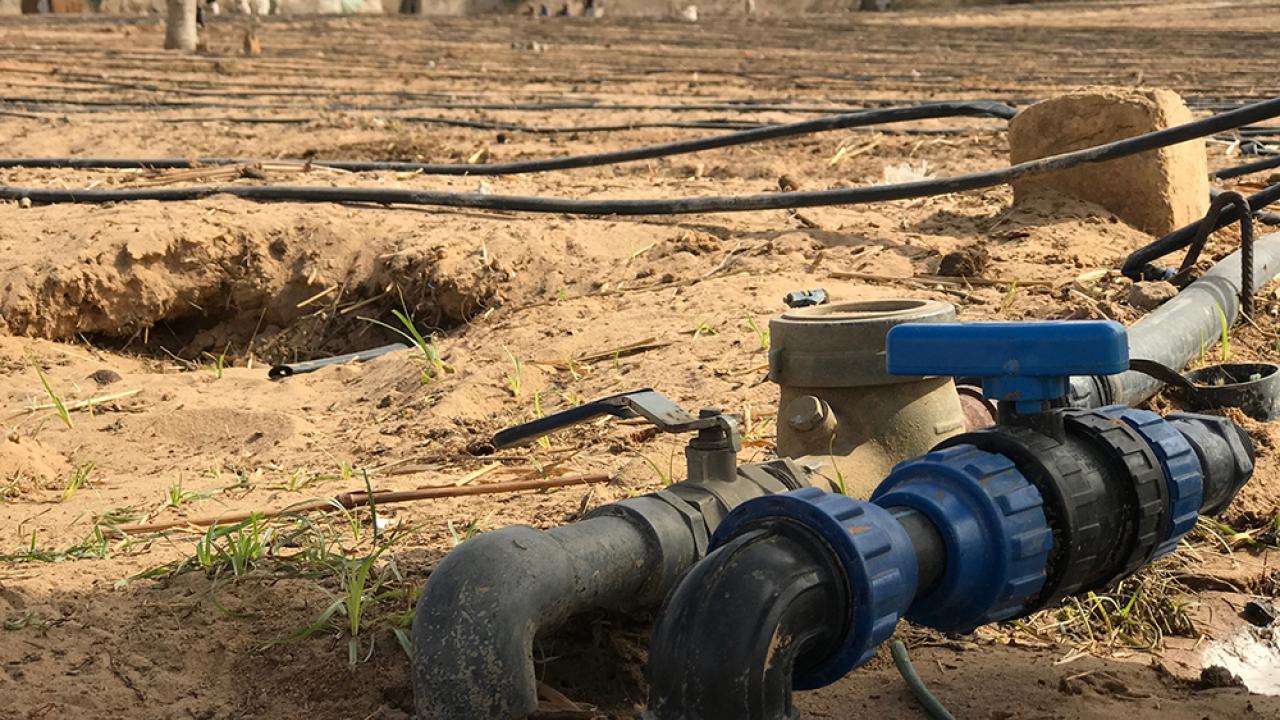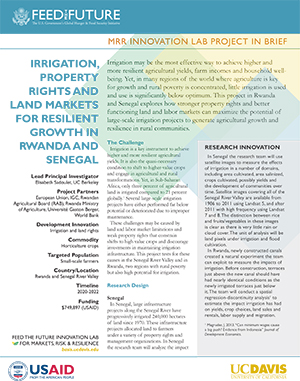
Irrigation may be the most effective way to achieve higher and more resilient agricultural yields, farm incomes and household well-being. Yet, in many regions of the world where agriculture is key for growth and rural poverty is concentrated, little irrigation is used and use is significantly below optimum.
This MRR Innovation Lab project in Rwanda and Senegal explores how stronger property rights and better functioning land and labor markets can maximize the potential of large-scale irrigation projects to generate agricultural growth and resilience in rural communities.
Project overview
Lead Principal Investigator: Elisabeth Sadoulet, UC Berkeley
Project Partners: European Union, IGC, Rwandan Agricultural Board (RAB), Rwanda Ministry of Agriculture, Université Gaston Berger, World Bank
Development Innovation: Irrigation and land rights
Commodity: Horticulture crops
Targeted Population: Small-scale farmers
Country/Location: Rwanda and Senegal River Valley
Timeline: 2020-2023
Funding: $680,406 (USAID)
The Challenge
Irrigation is a key instrument to achieve higher and more resilient agricultural yields. It is also the quasi-necessary condition to shift to higher-value crops and engage in agricultural and rural transformations. Yet, in Sub-Saharan Africa, only three percent of agricultural land is irrigated compared to 21 percent globally.[1] Several large-scale irrigation projects have either performed far below potential or deteriorated due to improper maintenance.
These challenges may be caused by land and labor market limitations and weak property rights that constrain shifts to high value crops and discourage investments in maintaining irrigation infrastructure. This project tests for these causes in the Senegal River Valley and in Rwanda, two regions with rural poverty but also high potential for irrigation.
Research Design
Senegal
In Senegal, large infrastructure projects along the Senegal River have progressively irrigated 240,000 hectares of land since 1970. These infrastructure projects allocated land to farmers under a variety of property rights and management organizations. In Senegal the research team will analyze the impact of irrigation on agricultural productivity and diversification, the sustainability of agriculture and regional development.
The research team will combine satellite images from across the Senegal River Valley with irrigation roll-out dates and 2017 census data from SAED and the National Statistical Agency to measure irrigation’s impacts on agricultural productivity and diversification. Images taken by Landsat 5 and Landsat 7 and 8 since as early as 1986 show a clear distinction between rice and fruits/vegetable cultivation.
Satellite images show that irrigated land is often at first used intensively followed by a decline as soils become salinized due to improper irrigation and drainage canal maintenance. A lack of secure property rights may be responsible for a deficit in farmers’ investments in the long-term maintenance of irrigation infrastructure. The team will test this through variation in how irrigation projects assign land and certify property rights. They will obtain data on intensity of land use and eventual abandonment from satellite imagery.
Irrigation development can create not only agricultural jobs but also non-agricultural jobs that complement incomes. The research team will estimate non-agricultural impacts that include the development of communities, formal and informal enterprises and income and welfare all resulting from irrigation.
Rwanda
In Rwanda, irrigation has an enormous potential to improve the lives of smallholder farmers. Implemented by the Rwandan Ministry of Agriculture (MINAGRI), the Land Husbandry, Water Harvesting, and Hillside Irrigation (LWH) project began in 2015 and will have 25,000 HA of hillsides under irrigation by 2020.
A 2020 study[2] showed that the LWH irrigation allows farmers to adopt horticultural crops in the dry season when cultivation would be otherwise impossible, increasing annual cash profits by as much as 70 percent. However, just over half of LWH-irrigated land remains cultivated only during the rainy seasons and almost exclusively with staple crops.
Households are constrained in selling labor in rural areas, which leads to a misallocation of land: too much land is held by small households who are unable to supply the labor needed for irrigation. Resolving frictions in either land or labor markets, could therefore lead to greater irrigation use and agricultural profits.
The research team will conduct an experiment that seeks to alleviate land and labor market constraints that prevent the full use of LWH irrigation potential. Prior focus group discussions in the area have highlighted the limited and informal means of learning about land rental opportunities. In 2019, the research team trained Rwandan Agricultural Board (RAB) “lead farmers” to collect and disseminate information on land rentals in 55 randomly selected villages. This sample will be the foundation of this project.
 Development Impact
Development Impact
This project is closely aligned with ongoing USAID agricultural programs and government irrigation efforts in both Rwanda and Senegal. Going from research to action through partners in the research project will help demonstrate the potential that well-managed irrigation can have.
In Rwanda, the team is partnering with the RAB and the Ministry of Agriculture. The RAB can scale these treatments up through its lead farmer system nationwide. In Senegal, the results will contribute to efforts by University Gaston Berger, the SAED and the Government of Senegal to increase the potential and impact of Fleuve Valley irrigation.
[1] FAO, 2019
[2] Jones, M., et al. 2020. “Factor Market Failures and the Adoption of Irrigation in Rwanda” NBER Working Paper.
